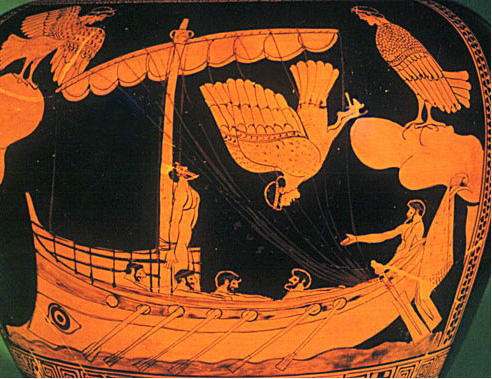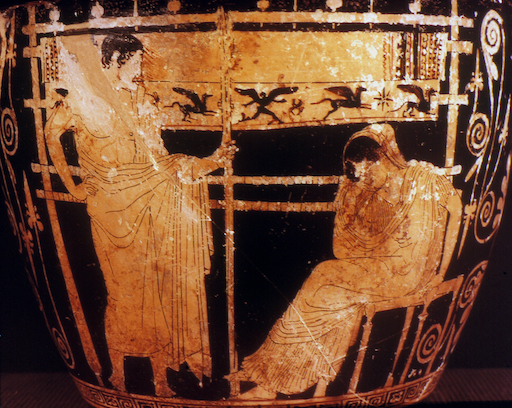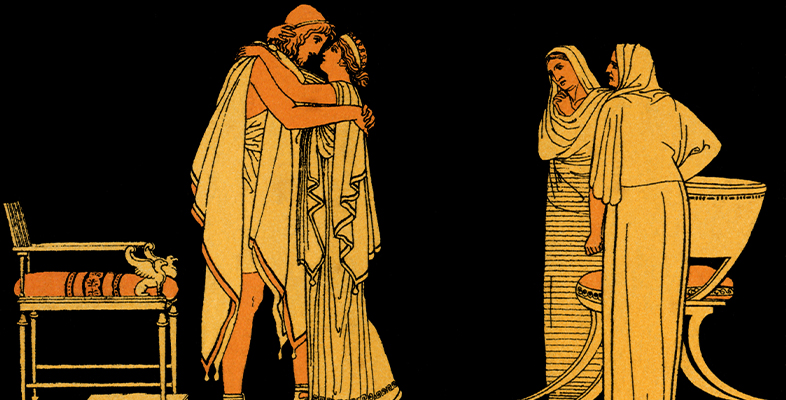3.3 Comparing Penelope and Odysseus
You may have begun to notice some differences between the ways in which Penelope and Odysseus are represented in the Odyssey. From the outset Odysseus is positioned as the poem’s central character; this is very much going to be a story about him and his adventures. While he is out exploring the world, Penelope is waiting patiently at home; we might even say that she is hidden away. Figures 7 and 8, both showing painted pottery from the fifth century BCE (several centuries after the Odyssey was first composed), depict elements of the story of the Odyssey and capture this contrast in visual form. Figure 7 shows one of Odysseus’ adventures aboard his ship: his encounter with the monstrous Sirens, which is related in Book 12 of the Odyssey. The Sirens are usually depicted as hybrid creatures, half-woman and half-bird; in the Odyssey they lure sailors to their deaths with their beautiful singing (Figure 7). As depicted in this image, Odysseus, in order to be able to hear their singing, has his crew tie him to the ship’s mast while they block their own ears with wax. By comparison, Figure 8 depicts Penelope at home, at her loom.

The contrast between Penelope’s confinement at home and Odysseus’ adventures far and wide is reinforced shortly after the extract which you read in Activity 5. Penelope asks the bard to sing a different song as the story of the Greeks’ returns from Troy is upsetting for her to hear, as it reminds her of Odysseus. She says:
a
singular grief, one that I cannot forget, comes over me as I
yearn for someone whom I think of constantly, a man whose
fame spreads widely throughout Hellas.
In response, her son Telemachus steps in and rebukes her for making this request, dismissing her feelings on the matter and instructing her:
Go back to your rooms and take charge of your own tasks,
the loom and the distaff, and order your women servants
to go about their work. Talk must be men’s concern, all of
them, and mine especially, for the power in the house is mine.
Telemachus’ words silence Penelope’s attempt to describe her own experience and emotions, and he quite literally tells her to hide away. There is a clear division of gender roles here, too. Having emerged from her seclusion in the women’s part of the house, Penelope is swiftly sent back again and told to attend to tasks relating to cloth production which were traditionally the work of women in ancient Greek society; as pointed out earlier, one of the things with which Penelope is particularly associated is her work at the loom (Figure 8). It is also made very clear here that if there is any talking to be done, it will be done by men. This might set us thinking about who is given the space to tell their story, or to have their story told, in the Odyssey. You’ll think some more about this when you examine the reunion of Penelope and Odysseus later in the course.

Despite this obvious contrast between the situations of Penelope and Odysseus, you may still have spotted some possible similarities between the way in which the two characters are described. Both are special in some way – you’ll remember that we read that Penelope is described as ‘glorious among women’ (Odyssey 1.332) which suggests that she stands out from other women, just as Odysseus is an extraordinary character. Her thoughtfulness or circumspection might also be seen to mirror one of Odysseus’ key attributes – his cunning – and it is clear from these early encounters with both characters that, although their experiences differ vastly, both have suffering of different kinds to endure.
